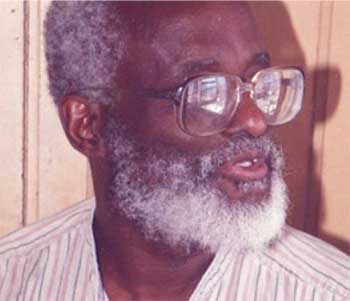
GARTH St Omer, ‘a writer ahead of his time’ (FRC, 2018), was a ‘gifted St Lucian novelist (who, up to his death, was) still unknown in his country’ (Crusader, 1992:1) despite what Kenneth Ramchand described in a lecture on ‘Literature, the University and West Indian Society’ delivered in St Lucia in commemoration of Harold Simmons as a ‘bitter love’ for St Lucia. That ‘bitter love’ was reflected in all his major works: Syrop (1964), A Room on the Hill (1968), Shades of Grey (1968) which comprised two novellas (Lights on the Hill and Another Time, another Place), Nor Any Country (1969), J – , Black Bam and the Masqueraders (1972) and Prisnms (2015). Often regarded ‘as difficult, as pessimistic, as irrelevant’ (according to Ramchand), this ‘writer of rare distinction’ (which is how Andrew Salkey described him in a BBC World Service commentary) was ‘without doubt, a novelist of immense stature, unique and unorthodox… and a worthy exponent of creole literature’ (Jn Pierre, 1993:20).
Yet, paradoxically, two young St Lucians had contrasting assessments of St Omer. Margot Gill, in a 1972 thesis, concluded that the ‘St Omer novels apparently were not written for the West Indian reader’ while, more recently, in a 2018 Folk Research Centre tribute to Garth St Omer, Malica S. Willie is quoted as explaining that St Omer ‘wanted to explain his Caribbean society to itself’. Which is correct: St Omer who is ‘myopic’ (Gill, 1972) and ‘lacks vision and foresight’ (Gill, 1972) or St Omer who ‘explain(ed) ourselves to us’ (Willie, 2018) through ‘complex characters to simultaneously hate & understand’ (Willie, 2018)?
Be that as it may, Gill (1972:42) insightfully concluded Lee) and the modern or contemporary (exemplified by the play, An KwiDouvanJou, written by Michael Fontinelle and the calypso, Lèt-la, by popular St. Lucian calypsonian Protus ‘Educator’ Auguste).
The novels of Garth St Omer, without doubt, are prototype creole novels, part of a body of contemporary creole literature, although some who will argue that that can’t be the case since the St Omer novels are all written in English. Jn Pierre (2017) counter-argues, however, that ‘it is not the language that qualifies a work as Creole literature but its portrayal of Creole society and Creole people’ (p 305).
Be that as it may, let us consider some critical elements of the novels of Garth St Omer viz themes, plots, points of view, voice and narrative style. Most of St Omer’s novels are set in St Lucia. In them, St Omer explores themes like ‘madness, sibling rivalry, intergenerational conflict, religion, illegitimacy and its social responses, exile and return, success…responsibility for oneself and others’ (Bush, 1986:406); island insularity; the impermanence of things; sin, guilt and punishment; expediency vs morality; pretense; rejection; intrinsic conflicts; violence and; death. All these themes emerge out of St Lucia’s creole milieu although they are not exclusive to that milieu.
Likewise, the plots where it can be argued that they exist, are not exclusive to St Lucia’s creole milieu; they lack definition. The emphasis is on the narration of seemingly unrelated events rather than on a straight forward narrative exposition of human character. They are seemingly disorderly and episodic and kept coherent primarily by the speed of their evolution as is typical of creole stories.
Speed of evolution, in true creole style, also account for the coherence of the narratives be they from first or third person perspectives. Whatever the perspective, the stories reflect an affinity with St Lucia’s creole reality except in one or two instances when it becomes difficult to decide whether the writer loses the ability to mask latent anti-creole sentiments or whether he inadvertently exposes anti-creole attitudes in the society which are at odds with his own bias. In ‘A Room on the Hill’, for example, he compares the frolic of children following Old Alphonse to the ‘milling activity of worms in a pit latrine’ (p175) and he describes the drumming and flute music of the masqueraders, in that same novel, as ‘an inharmonious agglomeration of sound, conflicting, muted with distance, but pervasive, and as grotesque as a musical parody’ (p162).
The narration of events and experiences are more important to St Omer than character exposition so most characters are shadowy even when they feature throughout the novels. These characters are proto-type creole characters, predominantly poor, disadvantaged and alienated even within their own changing creole society. Yet, the Garth St Omer stories generally employ creole folk forms such as the masquerade, carnival, funeral and house parties as subjects and channels of advocacy. Some of the stories, like the story of Ann Marie’s funeral preparation and procession and the story of the fishermen in the rum shop by the sea (both in ‘A Room on the Hill’) typify creole folk customs. Suffice it to say that form and story in the novels are almost exclusively creole in the same way that form and story in the English novel is almost exclusively English.
The novels employ popular language as is used in ordinary discourse. Characters code-switch. They speak creolized English sometimes, simple standard English at times and Creole at other times. The narration is parenthetical and desultory as is typical of creole story-tellers. It is dry, terse prose, sensitively meticulous. The language of the narration is markedly similarity to the language of the characters and the language that a creole readership would normally utilize. Consider this extract from ‘A Room on the Hill’, for example:
“You are the woman the most beautiful here,” he said.
He wanted to tell her so with his hands, his thighs; with all of himself.
She smiled.
“Why I don’t see you here before?”
“I don’t know’on,” her voice lifting. He felt he should never let go.
“You come here often?” (p110)
The common voice of narrators and characters has a poetic touch enhanced by the symbolism of the literary devices used such as this simile from ‘J -, Black Bam and the Masqueraders’:
My memory of myself getting up from that bench is one of exaggeratedly slow and deliberate movement, like that of a beggar lingering to be noticed. (p35)
That memory and image of ‘a beggar lingering to be noticed’ (p35) is striking and quite poignant and almost guaranteed to stir the sentiments of the reader. Paul does not realise that he is indeed a beggar, not of alms but of the attention of those who live in the houses by the Square.
In all his work, St Omer seems obsessed with the psychological strains of creole people both at home and abroad. It may well be that the novels are products of a kind of psycho-therapy to deal with a sense of hopelessness that permeates the psyche of both the writer, a creole expatriate, and creole society, generally.
The novels of Garth St Omer definitely exemplify ‘a new kind of novel’ (Gill, 1972:42), part of a growing catalogue of contemporary creole literature. They facilitate an appreciation and articulation of the intricate oscillations of that body of literature so that that literature can assume a lofty position within a grand creole culture in the evolution of a unique creole aesthetic.
References
Bernabé J, Chamoiseau P, Confiant R and Taleb-Khyar M B (Translator) (1990) ‘In praise of Creoleness’ Callaloo 13 (4): 886 – 909
Bush, RE (1986) ‘Garth St Omer (1931 – )’ in Daryl Cumber Dance (ed), Fifty Caribbean Writers: A Bio-bibliographical Critical Sourcebook New York: Greenwood Press
Chamoiseau P (2012) ‘From Creolization to Relation’ in Olivia Sheringham (interviewer) An interview with Patrick Chamoiseau<www.migration.ox.ac.uk/odp> (accessed 1 May, 2018)
Crusader (1992) Saturday, 1st February, 1992
Folk Research Centre (2018) ‘FRC pays tribute to Garth St. Omer: 1931-2018’ A press release <https://stluciatimes.com/2018/04/26/frc-pays-tribute-to-garth-st-omer-1931-2018/> (accessed 26 April, 2018)
Gill M (1972) A Brief Review of Garth St Omer’s Three Novels unpublished dissertation, St Lucia Teachers’ College
Jn Pierre K (2017) ‘Operation Restoration: From Oraliture to Literature to Duration’, In: Lee JR & Charles I ed. The Road to Mount Pleasant: Selected Essays on St Lucian Culture. Castries: MPAFRC, pp 301 – 313
Jn Pierre K (1993) ‘A Room on the Hill’ and ‘J-, Black Bam and the Masqueraders’: A Study of the Novels of Garth St Omer to Determine the Extent to which they Reflect Creole Literature’ unpublished DULCC Thesis, Universite des Antilles et de la Guyane
Willie MS (2018) in ‘FRC pays tribute to Garth St. Omer: 1931-2018’ A press release <https://stluciatimes.com/2018/04/26/frc-pays-tribute-to-garth-st-omer-1931-2018/> (accessed 26 April, 2018)














May I request a PDF version of this article? One of the chapters from the PhD dissertation deals with St. Omer’s A Room on the Hill, and I need all the essays and criticism I can find. If at all possible, could you please send me a link to your unpublished 1993 dissertation on St. Omer? I will only use it to aid my own work, and will include it on my Works Cited page. Please respond as soon as you can. Thank you for your time and attention.